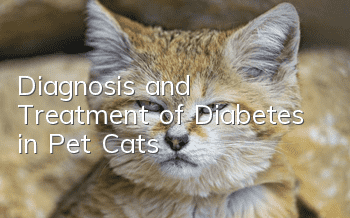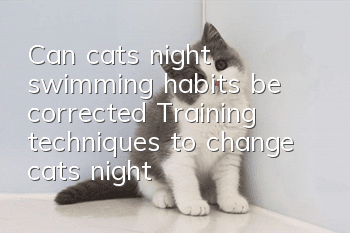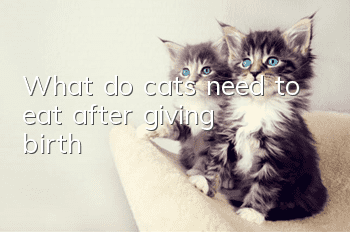Diagnosis and Treatment of Diabetes in Pet Cats

Feline diabetes refers to a nutritional metabolic syndrome caused by defective insulin secretion or impaired biological action, or both. The clinical symptoms of this disease are three more, one low and one high, namely polydipsia, polyphagia, polyuria, weight loss and elevated blood sugar. Clinically, the incidence of feline disease is not high, but with the increase in the number of pet cats in recent years, coupled with the increase in pet snack varieties, the number of obese cats has increased, and the incidence of diabetes has also increased. This article shares with you the diagnosis and treatment of feline diabetes.
1. Incidence of disease
Brown pear cat, ten years old, female, weighing nine kilograms. In recent days, the pet owner has noticed that the cat has lost appetite and is listless. Recently, the cat has increased desire to drink, increased urine output, and the urine smells like rotten apples. , the weight has decreased significantly, and is currently only 5 kilograms, so he was taken to our hospital for treatment. A general clinical examination revealed that the cat was lethargic, lethargic, emaciated, and slightly dehydrated. The abdominal circumference is significantly increased, the abdomen feels undulating when palpated, the abdominal wall is tense, and there is constant wailing during palpation.
2. Laboratory examination
1. Routine blood examination
2. Serum biochemical examination
3. Urine test
Perform urine analysis with Mindray urine analyzer. The analysis results are as follows: urine specific gravity is lower than 1.00, urine pH is 6.1, grape is lower than 1300 U/L, urinary ketones are lower than 85 mg/dL, and urine occult blood and white blood cells are positive. , two consecutive morning urine urinalysis tests were performed to obtain stable results, and both urine sugar and urine ketone body tests were positive.
4. Imaging examination
Use an X-ray machine to perform a lateral abdominal examination. The examination results are: The uterine horns in the abdomen are enlarged, and the gray shadow is filled with fluid.
5. B Ultrasound imaging
Use a B-ultrasound machine for abdominal examination, and the examination results are: abdominal uterine horns are swollen, the uterine wall is thickened, and there is a dark shadow of fluid.
3. Clinical diagnosis
After consultation, it was found that the cat had been obese before the onset of the disease and often ate meat and fish with high fat content. Based on the general clinical symptoms and general clinical physical examination, the disease could be initially diagnosed as diabetes complicated with pyometra. . Combined with the results of urinalysis and serum biochemical tests, the cat can be diagnosed with diabetes. If the globulin and albumin in the serum are lower than normal, the possibility of complications from other diseases can be considered. Routine blood tests showed that the number of white blood cells, red blood cells and neutrophils were all higher than normal. Combined with the results of X-ray imaging and B-ultrasound examination, the disease was diagnosed as diabetes complicated with pyometra.
4. Treatment
Based on the cat’s examination, the treatment plan is to use insulin to lower blood sugar, use lipid-lowering drugs to lower blood lipids, infuse fluids to correct water, electrolyte and acid-base balance disorders, and combine symptomatic therapy with dietary therapy. After physical recovery, hysterectomy and oophorectomy are performed if the examination results permit.
1. Insulin combined with hypoglycemic drug treatment
Use synthetic long-acting insulin to subcutaneously inject 8U half an hour before feeding in the morning and evening, and take 1.6 mg of hypoglycemic insulin orally once a day after meals; Lipingzhi, orally 2 times a day. Adjust the morning and evening insulin dosage based on basal blood sugar and postprandial blood sugar levels. Measure blood sugar levels regularly, and adjust the morning and evening dosage ratio based on the relative levels of blood sugar levels after breakfast and dinner until blood sugar fluctuations are controlled within the normal range.
Figure 4 Insulin can lower blood sugar
Figure 4 Insulin can lower blood sugar
2. Daily feeding and management
Feed Royal Diabetes prescription cat food regularly and quantitatively every day, control the total water intake, and drink small amounts of water frequently. Do not adjust to your daily eating habits until your blood sugar returns to the normal range.
3. Symptomatic therapy and control of secondary infections
Intravenous infusion of lactated Ringer's solution and normal saline. Since polyuria and ketoacidosis are easily accompanied by hypokalemia, an appropriate amount of potassium chloride solution should be added during intravenous infusion based on the animal's urine output and ketone body examination results, and antibiotics such as ceftriaxone sodium should be given to control infection.
4. Hysterectomy and oophorectomy
After a period of treatment, the cat’s physical condition gradually recovered, and she basically met the surgical conditions for hysterectomy and oophorectomy. Under general anesthesia with supine Baoding and breathing anesthesia machine, the abdominal cavity is routinely opened, the uterus is found, the mesoovary is ligated, the broad ligament of the uterus is separated, the uterine body is ligated and removed, and the abdominal wall incision is routinely closed. After the operation, systemic antibiotics were used for 7 days, painkillers were given, and a cervical collar was put on.
5. Discussion and Summary
1. Obesity is a cause of diabetes. The increase in blood sugar concentration caused by diabetes stimulates the hypothalamus feeding center and causes an increase in appetite. It also increases plasma osmotic pressure and blood vessel permeability, causing a positive clinical urine glucose test; at the same time, due to The ability to decompose glucose decreases, and the body cannot use enough glucose as an energy source, resulting in an increase in relative energy consumption, and an increase in the amount of water taken away by glucose through urine, ultimately leading to an increase in the body's desire to drink, weight loss, weight loss, and a decrease in immunity. Abnormal secretion of hormones in the uterus acts on the mucosa of the uterine wall, causing secondary bacterial infection, causing uterine serous exudative inflammation. As the accumulation of fluid increases, feline diabetes complicated by pyometra occurs.
2. When treating diabetes in cats, you must pay attention to the dosage of insulin. Excessive dosage will cause iatrogenic hypoglycemia. The dosage of insulin should be measured according to the dailyInjection is carried out based on blood sugar results, and the injection time is preferably fixed about half an hour before feeding. In cats complicated by pyometra, toxins in the uterus are absorbed into the body, causing septicemia and death. Therefore, while treating diabetes, we should control the lesions of pyometra and use systemic antibiotics to control secondary infections.
3. The treatment of diabetes should attach great importance to the treatment of complications, and once symptoms similar to diabetes are found, they should be treated as early as possible to avoid delaying the best time for treatment.
- What effect does Moutian Polygonum have on cats? Is it harmful to cats?
- The quickest solution to a bloated cat’s belly
- Why doesn’t the cat’s fur grow even after being shaved for half a year?
- Catnip planting season
- If you knew these shortcomings of a Ragdoll cat, would you still be willing to keep it?
- What should pregnant cats eat? Can female cats use milk powder to supplement their nutrition when pregnant?
- What is the best food for American wirehair cats?
- Which color is better for Isle of Man tailless cats?
- Do Munchkin cats have genetic defects?
- If your cat at home encounters the following problems, do you know what to do?



